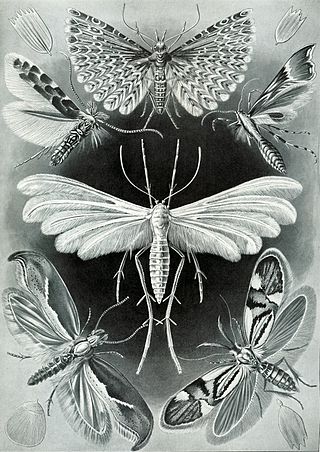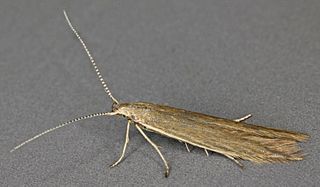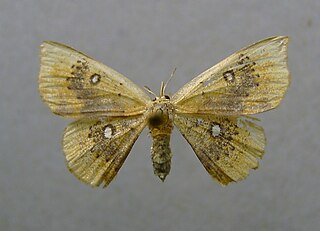
Microlepidoptera (micromoths) is an artificial grouping of moth families, commonly known as the "smaller moths". These generally have wingspans of under 20 mm, so are harder to identify by external phenotypic markings than macrolepidoptera. They present some lifestyles that the larger Lepidoptera do not have, but this is not an identifying mark. Some hobbyists further divide this group into separate groups, such as leaf miners or rollers, stem or root borers, and then usually follow the more rigorous scientific taxonomy of lepidopterans. Efforts to stabilize the term have usually proven inadequate.

Eulithis prunata, the phoenix, is a moth of the genus Eulithis in the family Geometridae.

Rhodometra sacraria, the vestal, is a moth of the family Geometridae. The species was first described by Carl Linnaeus in his 1767 12th edition of Systema Naturae.

Petrophora chlorosata, the brown silver-line, is a moth of the family Geometridae found in Asia and Europe. The larva feed on bracken. It was first described by the Italian physician and naturalist, Giovanni Antonio Scopoli in his 1763 Entomologia Carniolica.

The Broom Moth(Ceramica pisi) is a moth of the family Noctuidae. It is found in all of Europe, East across the Palearctic to Siberia and the Russian Far East. In the north, it is found far beyond the Arctic Circle and in the south to northern Spain. In the Alps, it is found at heights of up to 2,000 metres.

The hemlock moth, also known as the defoliating hemlock moth or poison hemlock moth, is a nocturnal moth species of the family Depressariidae. Of Palaearctic origin, it was first found in North America in 1973 when it was accidentally introduced. The moth is now widespread throughout the northern half of the United States, southern Canada, northern Europe, and, more recently, New Zealand and Australia. The larval form grows to around 10 mm, while the adults wingspan is between 17 mm and 19 mm.

Clostera anachoreta, the scarce chocolate-tip, is a moth of the family Notodontidae. The species was first described by Michael Denis and Ignaz Schiffermüller in 1775. It is found from Europe up to Japan and Korea.

Coleophora artemisicolella is a moth of the family Coleophoridae found in Europe and across the Palearctic.

The Erebidae are a family of moths in the superfamily Noctuoidea. The family is among the largest families of moths by species count and contains a wide variety of well-known macromoth groups. The family includes the underwings (Catocala); litter moths (Herminiinae); tiger, lichen, and wasp moths (Arctiinae); tussock moths (Lymantriinae), including the arctic woolly bear moth ; piercing moths ; micronoctuoid moths (Micronoctuini); snout moths (Hypeninae); and zales, though many of these common names can also refer to moths outside the Erebidae. Some of the erebid moths are called owlets.

Pyralis manihotalis is a moth of the family Pyralidae described by Achille Guenée in 1854.
Coleophora sternipennella is a moth of the family Coleophoridae. It is found in all of Europe, except Greece and the Mediterranean islands. It is also known from the Caucasus. It occurs in steppe and desert biotopes, in wasteland and uncultivated parts of anthropogenic areas.
Coleophora vulnerariae is a moth of the family Coleophoridae. It is found from Norway and Sweden to the Iberian Peninsula, Italy and Greece and from Great Britain to the Baltic states, Romania and Bulgaria. It is also found in southern Russia.
Coleophora aestuariella is a moth of the family Coleophoridae. It is found in Great Britain, France, the Iberian Peninsula, Greece, Bulgaria and Ukraine.
Coleophora amethystinella is a moth of the family Coleophoridae, found in Asia and Europe.

Coleophora argentula is a moth of the family Coleophoridae, found in most of Europe, Russia and Asia Minor. The larvae live in cases and feed on the seeds of yarrow and sneezewort.

Coleophora alticolella is a moth of the family Coleophoridae, found in Europe and North America.
Coleophora antennariella is a moth of the family Coleophoridae. It is found from Great Britain to Romania, Poland, the Baltic states and northern Russia and from Fennoscandia to France, Italy and Hungary.

Dioryctria zimmermani, the Zimmerman pine moth, is a moth of the family Pyralidae. It is found from southern Canada and the north-eastern and Great Lakes areas of the United States. There is a disjunct population in eastern Nebraska.

Cyclophora albiocellaria is a moth of the family Geometridae. It is found in south-eastern Europe and parts of Central-Asia.
Eremberga insignis is a species of snout moth in the genus Eremberga. It was described by Carl Heinrich in 1939 and is found in Texas and Mexico.












